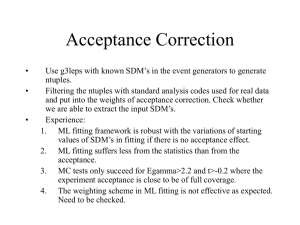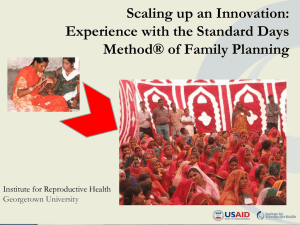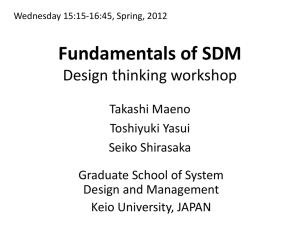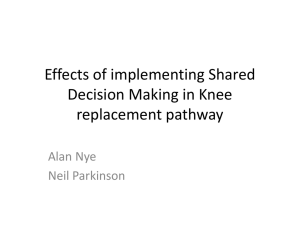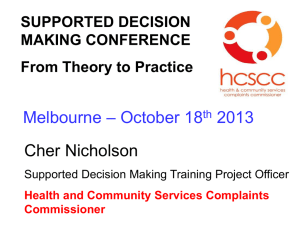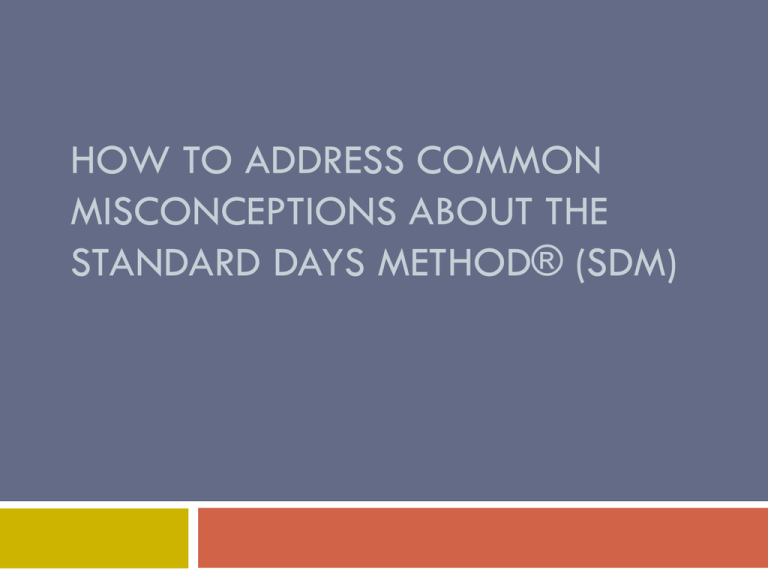
HOW TO ADDRESS COMMON
MISCONCEPTIONS ABOUT THE
STANDARD DAYS METHOD® (SDM)
Common misconceptions about SDM
1.
2.
3.
4.
5.
6.
7.
8.
9.
10.
“Because SDM is natural, it can’t be very effective.”
“SDM does not seem like a modern method.”
“SDM sounds just the same as the rhythm method.”
“Women will not have the power to decide when to have sex.”
“Men won’t like this method.”
“If we offer this method, clients using modern methods will
switch to SDM.”
“There wouldn’t be much demand for SDM.”
“SDM counseling would take too much time, just like other
natural methods.”
“It would be hard for illiterate women to use SDM.”
“More educated women would not be interested in using
SDM.”
“Because SDM is natural, it can’t be very
effective.”
Fact: SDM is a natural, effective method
Rigorously tested in a multi-site efficacy trial.
Found to be 95% effective with correct use.
Efficacy rate compares to other user-directed
methods.
Successful use requires motivation by the couple to
avoid unprotected sex during the fertile window.
97% of the couples in the efficacy study followed
this rule.
SDM efficacy study
Multi-site prospective study
Services provided in existing programs
Clients followed monthly for 13 cycles
478 women in the study, 43 became pregnant
Couples used the method correctly in 97% of cycles
With correct use, the failure rate is 4.8
With typical use the failure rate is 12.0
Comparing effectiveness of FP methods
Source: Family
Planning: A Global
Handbook for
Providers 2007,
WHO
“SDM does not seem like a modern
method.”
Fact: SDM is a modern FP method
Based on recent findings of research in
reproductive biology.
Developed following the scientific model and
using modern research tools, including
computer modeling.
Clinically tested following universally accepted
research methodology.
It is included in State of the Art (SOTA)
guidelines published by WHO.
Standard Days Method is based on:
1. Probability of pregnancy
relative to ovulation.
Viable sperm – up to 5 days
Viable egg – up to 24 hours
2. Timing of ovulation.
Menstrual Cycle mid-point ± 3 days
Probability of Pregnancy from Intercourse on
Days Relative to Ovulation
Ovulation
35%
30%
25%
20%
15%
10%
5%
0%
-9
-8
-7
-6
-5
-4
-3
-2
-1
0
1
2
Cycle Days
Source: Wilcox et al. 1998
Probability of ovulation relative to midpoint of
the cycle
30.1
% of cycles
30
25
18.4.
20
15
12.1
10
5
0
Peak day used as
proxy of ovulation
11.9
8
5.6
2.4
4.3
< -4
-3
-2
-1
Midpt
Days
1
2
3
0.9
4
>
Source: IRH analysis of WHO 1981 data
Determining the fertile window
Day 8
Day 19
Included in SOTA documents
IPPF Medical Bulletin – 2000, 2003
IRH Reference Guide – 2002
WHO Medical Eligibility Criteria – 2002, 2004
WHO Selected Practice Recommendations – 2004
Contraceptive Technology – 2004, 2007
USAID Global Health Technical Briefs – 2004
Pocket Guide to Managing Contraception – 2004
Pop Report (New Contraceptive Methods) – 2005
WHO FP Decision-Making Tool – 2005
WHO Global Handbook for Family Planning – 2008
Pop Council Balanced Counseling Strategy – 2006
Ministries of Health norms and policies 2003 – 2010
Resources – FAM Project Brief
Interested in more information about
SDM as a modern method of family
planning?
Read The Standard Days Method®:
A Modern Family Planning Method.
“SDM sounds just the same as the rhythm
method.”
How is the SDM different from the Rhythm
Method?
Standard Days Method
SDM uses a fixed formula
for the fertile phase
SDM clients use the same
fertile window for all cycles
SDM has been tested in a
well-designed clinical trial
Rhythm Method
Rhythm requires information
about the previous 6 cycles
Rhythm users must make
complex monthly
calculations
Rhythm has never been
tested in clinical trials
“Women will not have the power to
decide when to have sex.”
Fact: SDM is best suited for couples that can
communicate about sex
SDM is unlikely to succeed with couples whose
relationship is characterized by gender inequity
and gender-based violence
For correct SDM use, it is important:
That
both the woman and man agree about whether or
not they want a pregnancy
That both understand how SDM works
FP counselors encourage couples to decide how to
manage the fertile days beforehand
Providers need to be trained on how to
provide counseling support to the couple
Before
(n=55)
After
(n=57)
Offered to meet with partner
n/a
77%
Considered role of partner
n/a
70%
Discussed STI risk
8%
16%
Explored condom knowledge
n/a
38%
Explained condom use
n/a
19%
Honduras Simulated Client Study (Baseline and Endline Results)
Counseling should address options for
managing the fertile phase
Admission
Exit
Rural India
30%
35%
Urban India
87%
98%
El Salvador
25%
34%
Philippines
22%
30%
Project reports, IRH
“Men won’t like this method…”
Fact: Men support SDM use
Results from efficacy trials
and introduction studies
show that men participate
in SDM use in a number of
ways:
Using a condom or abstaining
during fertile days
Following wife’s instructions
Keeping track of fertile days
Purchasing CycleBeads and
condoms
% of women who report that their partners
track fertile days
12%
10%
8%
6%
4%
2%
0%
CARE/India (n=427)
Partner counseled
El Salvador (n=142)
Not counseled
Exit interviews with SDM users in El Salvador/India
Comparison of mean coital frequency
All sexually active women
5.5 per cycle*
Withdrawal
4.9 per cycle*
SDM users
5.5 per cycle
*Stover et al, 2001
“If we offer this method, clients using modern
methods will switch to SDM.”
Fact: SDM integration has no negative effects
on FP use and method mix
Research shows that
SDM brings new users to
family planning
In fact, in the state of
Jharkhand, India, 87%
of new SDM users are
new to family planning
CPR in study area before and 18 months after SDM
introduction (rural villages, El Salvador)
Pre
Post SDM
Total prevalence
45%
58%
Permanent Methods
(T.L. and Vasectomy)
16%
19%
Birth Spacing Methods
28%
39%
SDM
0%
4%
Source: Community survey, Project Concern International, 2002
CPR in study area before and 18 months after
SDM introduction (urban slums, India)
Pre SDM
Post SDM
Total Prevalence
49%
58%
Tubal Ligation
20%
24%
DMPA
< 1%
1%
Condom
15%
17%
IUD
5%
5%
SDM
0%
1%
Source: Community survey, TNS MODE, 2004
What method were clients using two months
before adopting the SDM?
100%
80%
60%
40%
20%
0%
India
Nonuser/ Trad. User
Peru
Pill
Condom
Rwanda
Injection
LAM
Government Statistics collected during SDM Impact Study
Effect on method mix and contraceptive
prevalence
Percent of new family planning users accepting SDM
Countries/organizations
Percent of new users
Benin/ASPF
7.1
India/CASP
2.9
Ecuador/CEMOPLAF
2.2
Honduras/ASHONPLAFA
1.6
“There wouldn’t be much demand for SDM”
Fact: Demand exists for SDM and it is growing
1,792,285 sets of CycleBeads have been sold
worldwide from January 2004-May 2010
2010
2009
2008
2007
2006
2005
2004
0
50,000
100,000
150,000
200,000
250,000
300,000
350,000
400,000
CycleBeads sold per year as reported to the RHInterchange
450,000
500,000
Family planning use worldwide
(Women in Union)
No methods
43%
42%
8%
8%
49%
50%
Natural
methods
Modern methods
Levels and Trends of Contraceptive Use as Assessed in 1998. United
Nations, Report ESA/P/WP.155 New York, 1999
New SDM Users (4136 users by Dec 05)
254
260
235
New Users
210
211
220
231
224235
208
178
185
160
135
110
102
95
75 75
85
84
68
62
64 67
74
65
54
60
35
67 62 71 63 65
61 66 63
55
61
114 110
110
102 106
100
75
68
55
16
Se
t'
05
N
ov
'0
5
Ju
l '0
5
Se
t'
04
N
ov
'0
4
En
e
'0
5
M
ar
'0
5
M
ay
'0
5
Ju
l '0
4
-40
Se
t'
03
N
ov
'0
3
En
e
'0
4
M
ar
'0
4
M
ay
'0
4
Se
t'
02
N
ov
'0
2
En
e
'0
3
M
ar
'0
3
M
ay
'0
3
-15
Ju
l '0
3
10
Source: DISA San Martín
“SDM counseling would take too much time,
just like other natural methods.”
Fact: SDM is easy to teach in about the
same amount of time as other methods
Can be taught in about 20 minutes, even in
low-literacy settings
Continuation and correct use improved with 2nd
visit but not necessary
Comparison of SDM, sterilization, and pill
counseling at government clinics (Jharkhand, India)
Interpersonal
relations
Information
exchange
Session length
SDM
(n=59)
78%
Pill
(n=59)
78%
Sterilization
(n=59)
83%
64%
58%
44%
17 min.
13 min.
15 min.
Source: Simulated clients, endline
Medical barriers in Peru and Rwanda
Rwanda
25% of eligible clients
denied SDM because
partner not present
5% requested to track
cycles
Peru
46% of eligible clients
denied SDM because
partner not present or
requested to track
menstrual cycles
After reinforcement, virtually all eligible clients
received the method.
Source: Simulated clients, endline
“It would be hard for illiterate women to
use SDM.”
Fact: Low literacy or illiterate women can
learn how to use SDM correctly
It is entirely possible for low
literacy and illiterate women to
use this method. There is no
need for them to be able to
read in order to use it.
CycleBeads serve as a helpful
visual tool for women,
regardless of whether or not
they are literate
IRH has developed low-literacy
inserts to support method use
Among women and men who had heard of the
SDM, 70-90% knew that the SDM…
defines the fertile days as 8-19
comes with a visual aid
and that it requires:
26-32 day cycles
partner cooperation
abstinence/condom use
keeping track daily
Analysis of household surveys
“More educated women would not be
interested in using SDM.”
Fact: SDM appeals to women from a range of
socio-economic backgrounds
SDM is offered in over thirty countries worldwide,
including the United States, in both the public and
private sectors
Women worldwide choose SDM because:
It
is natural and free of health side effects
It teaches them about their fertility and helps them
monitor their cycle lengths
CycleBeads help women negotiate & discuss sex with
their partners

